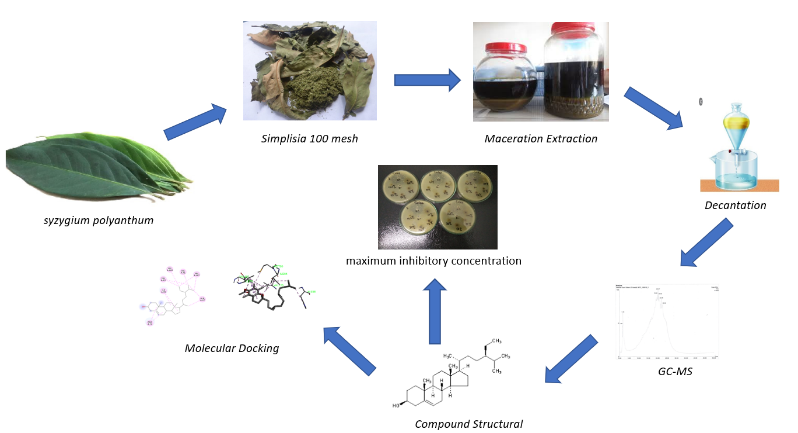Invitro Activity and Docking Approach In Silico Leaf Extract Syzygium polyanthum (Wight) Walp. as a Salmonella typhi Inhibitor
DOI:
https://doi.org/10.48048/tis.2022.5654Keywords:
Syzygium polyanthum (Wight) Walp., Leaf extract, MIC test, GC-MS, Docking in silicoAbstract
Indonesian people had long used plants as traditional medicine. In addition to maintaining health, traditional medicine was in great demand and prevents disease. We often encounter syzygium polyanthum leaves as a complement in tamarind and pepes, which were believed to act as a preservative. This study aimed to determine qualitatively bay leaf extract as an antimicrobial, Salmonella typhi. Methanol extraction of syzygium polyantum leaves would be partitioned with hexane and ethyl acetate solvents. The anti-microbial potential was shown in the Maximum Inhibitory Concentration (MIC) test, the identification of the compound using GC-MS and its potential as antibacterial was shown by docking the molecule using docking in silico technique against 5L3J protein. The MIC results were shown that the hexane partition at 100 ppm had 22.09 mm inhibition and the ethyl acetate partition at 80 ppm, had 18.15 mm inhibition. The GC-MS’ testing resulted of syzygium polianthum leaf extract showed the presence of alpha-pinene, alpha-cubenene, 1H-Cyclopropa [a] naphthalene, nerolidol, humulene epoxide II, phytol, 9,12,15-Octadecatrien-1-ol, Squalene, Alpha-tocopherol, Beta-sitosterol, azulene, valence, Azulene and beta-Panasinen. However, the lowest binding affinity value was obtained from the cytosterol compound of −9.45 kcal/mol in ethyl acetate and Valencene solutions of −6.93 kcal/mol in n-hexane solvent. While the positive control-Chloramphenicol was −36.93 kcal/mol. This means that the syzygium polyanthum leaf extract could be used as an alternative medicine for typhoid.
GRAPHICAL ABSTRACT
Downloads
Metrics
References
World Health Organization. WHO monographs on selected medicinal plants. Essent. Med. Health Prod. Inform. Portal 1999; 1, 183-94.
PM Dewick. Medicinal natural products: A biosynthetic approach. John Wiley & Sons, New Jersey, 2009.
S Sehwag and M Das. Composition and functionality of whole jamun based functional confection. J. Food Sci. Tech. 2016; 53, 2569-79.
S Hadisaputro. Prevention and control of typhoid fever. Med. J. Indonesia 1998; 7, 117-24.
RKR Pandit, D Gupta and TK Mukherjee. Identification of potential beta-lactamase TEM 1 inhibitors using peptidomimetics, virtual screening, and molecular dynamics simulations. Int. J. Pharm. Pharmaceut. Sci. 2018; 10, 91-6.
A Rochmat, A Hidayati, M Mujijah and S Suaedah. In silico study and bioactivity of flavonoid extract Syzygium polyanthum (Wight) Walp. leaves against Salmonella typhi. World Chem. Eng. J. 2020; 4, 39-45.
A Rochmat. Characterization of flavonoid compounds of bitter extract (Andrographis paniculata) which have inhibitory activity against cyclooxygenase-2 enzyme in vitro (in Indonesian). Jurnal Integrasi Proses 2015; 5, 81-7.
S Gul, A Eraj and Z Ashraf. Glycyrrhiza glabra and Azadirachta indica against Salmonella typhi: Herbal treatment as an alternative therapy for typhoid fever. Arch. Med. 2015; 7, 4.
BO Odjobo, N Ichoron, NP Igoli and JO Igoli. Using GC-MS for natural product analysis in Nigeria: Problems and prospects. J. Chem. Soc. Nigeria 2020; 45, 798-803.
G Samykannu, P Vijayababu and J Natarajan. Substrate specificities in Salmonella typhi outer membrane protease (PgtE) from Omptin family - An in silico proteomic approach. Inform. Med. Unlocked 2018; 12, 6-13.
A Khan, H Ahmed, N Jahan, SR Ali, A Amin and MN Morshed. An in silico approach for structural and functional annotation of Salmonella enterica serovar typhimurium hypothetical protein R_27. Int. J. Bioautomation 2016; 20, 31-42.
MA Islam and TS Pillay. Identification of promising anti-DNA gyrase antibacterial compounds using de novo design, molecular docking and molecular dynamics studies. J. Biomol. Struct. Dynam. 2020; 38, 1798-809.
J Sandika and JF Suwandi. Sensitivity test of Salmonella thypias causative of typhoid fever to severalantibiotics (in Indonesian). Majority 2017; 6, 41-5.
NE Sugijanto, D Anggraeny and NC Zaini. Antimicrobial activity of endophytic fungi Kabatiella caulivora var. B isolated from Alyxia reinwardtii BL (in Indonesian). Jurnal Ilmu Kefarmasian Indonesia 2011; 9, 31-4.
M Mamay, GN Mutmaina and DS Sopinah. Uji antibakteri ekstrak etanol daun salam (Syzygium polyanthum) dataran tinggi dan rendah terhadap pertumbuhan Salmonella sp (in Indonesian). In: Proceedings of the Seminar Nasional dan Penelitian Kesehatan, Semarang, Indonesia. 2018, p. 212-5.
A Ismail and WANW Ahmad. Syzygium polyanthum (Wight) Walp: A potential phytomedicine. Pharmacogn. J. 2019; 11, 429-38.
H Ugboko and N De. Mechanisms of antibiotic resistance in Salmonella typhi. Int. J. Curr. Microbiol. Appl. Sci. 2014; 3, 461-76.
ENA Abd Rahim, A Ismail, MN Omar, UN Rahmat and WANW Ahmad. GC-MS analysis of phytochemical compounds in Syzygium polyanthum leaves extracted using ultrasound-assisted method. Pharmacogn. J. 2018; 10, 110-9.
E Lionta, G Spyrou, DK Vassilatis and Z Cournia. Structure-based virtual screening for drug discovery: Principles, applications and recent advances. Curr. Top. Med. Chem. 2014; 14, 1923-38.
L Pinzi and G Rastelli. Molecular docking: Shifting paradigms in drug discovery. Int. J. Mol. Sci. 2019; 20, 4331.
PR Patel, H Joshi, U Shah, M Bapna and B Patel. New generation of quinazolinone derivatives as potent antimicrobial agents. Asian Pac. J. Health Sci. 2021; 8, 61-6.
F Rezaldi, O Taupiqurrohman, MF Fadillah, A Rochmat, A Humaedi and F Fadhilah. Identification of COVID-19 vaccine based on peptida from Spike glycoprotein of SARS CoV-2 to Asian ethnicity by in silico method (in Indonesian). Jurnal Biotek Medisiana Indonesia 2021; 10, 77-85.
Downloads
Published
How to Cite
Issue
Section
License

This work is licensed under a Creative Commons Attribution-NonCommercial-NoDerivatives 4.0 International License.







